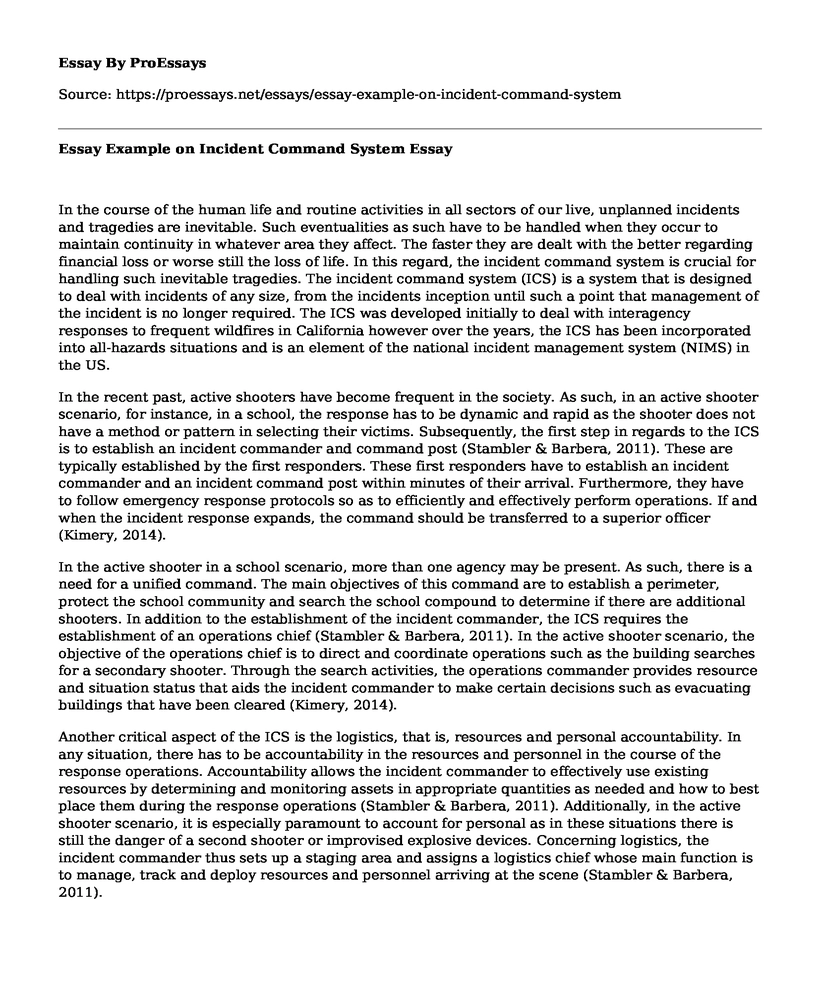In the course of the human life and routine activities in all sectors of our live, unplanned incidents and tragedies are inevitable. Such eventualities as such have to be handled when they occur to maintain continuity in whatever area they affect. The faster they are dealt with the better regarding financial loss or worse still the loss of life. In this regard, the incident command system is crucial for handling such inevitable tragedies. The incident command system (ICS) is a system that is designed to deal with incidents of any size, from the incidents inception until such a point that management of the incident is no longer required. The ICS was developed initially to deal with interagency responses to frequent wildfires in California however over the years, the ICS has been incorporated into all-hazards situations and is an element of the national incident management system (NIMS) in the US.
In the recent past, active shooters have become frequent in the society. As such, in an active shooter scenario, for instance, in a school, the response has to be dynamic and rapid as the shooter does not have a method or pattern in selecting their victims. Subsequently, the first step in regards to the ICS is to establish an incident commander and command post (Stambler & Barbera, 2011). These are typically established by the first responders. These first responders have to establish an incident commander and an incident command post within minutes of their arrival. Furthermore, they have to follow emergency response protocols so as to efficiently and effectively perform operations. If and when the incident response expands, the command should be transferred to a superior officer (Kimery, 2014).
In the active shooter in a school scenario, more than one agency may be present. As such, there is a need for a unified command. The main objectives of this command are to establish a perimeter, protect the school community and search the school compound to determine if there are additional shooters. In addition to the establishment of the incident commander, the ICS requires the establishment of an operations chief (Stambler & Barbera, 2011). In the active shooter scenario, the objective of the operations chief is to direct and coordinate operations such as the building searches for a secondary shooter. Through the search activities, the operations commander provides resource and situation status that aids the incident commander to make certain decisions such as evacuating buildings that have been cleared (Kimery, 2014).
Another critical aspect of the ICS is the logistics, that is, resources and personal accountability. In any situation, there has to be accountability in the resources and personnel in the course of the response operations. Accountability allows the incident commander to effectively use existing resources by determining and monitoring assets in appropriate quantities as needed and how to best place them during the response operations (Stambler & Barbera, 2011). Additionally, in the active shooter scenario, it is especially paramount to account for personal as in these situations there is still the danger of a second shooter or improvised explosive devices. Concerning logistics, the incident commander thus sets up a staging area and assigns a logistics chief whose main function is to manage, track and deploy resources and personnel arriving at the scene (Stambler & Barbera, 2011).
Conclusion
In conclusion, in a school active shooter scenario, the proper implementation of the ICS is paramount to ensure minimal casualties. In this scenario, the ICSs success depends on the prompt establishment of the incident commander and the incident command post. Subsequently, the incident commander can evaluate the situation and set up the missions objectives later assigning the operations chief, who directs and coordinates the various activities of the missions objectives and the logistics chief who ensures the appropriate and timely deployment of resources and personnel. It is only by establishing a clear chain of command that any situations under the ICS can effectively and efficiently be resolved.
References
Kimery, A. (2014, February 28). DHS Active Shooter After Action Reports Analyzed In FEMA Lesson Learned Trend Analysis. Retrieved from Homeland Security Today: http://www.hstoday.us/channels/dhs/single-article-page/active-shooter-after-action-reports-analyzed-in-fema-lessons-learned-trend-analysis/78512b6bdcb87764272ee77a6cd90297.html
Stambler, K. S., & Barbera, J. A. (2011). Engineering the Incident Command and Multiagency Coordination Systems. Journal of Homeland Security and Emergency Management.
Cite this page
Essay Example on Incident Command System. (2021, Mar 31). Retrieved from https://proessays.net/essays/essay-example-on-incident-command-system
If you are the original author of this essay and no longer wish to have it published on the ProEssays website, please click below to request its removal:
- Essay Example: Factors that Account for Significance and Visibility of Motor Carriers
- Heat Transfer From a Circular Cylinder Paper Example
- Why Do Bridges Ice Before Roads? Essay Example
- What Should Ray Include in His Job Description for the Director of Engineering Position? - Essay Sample
- Evaluating the Physical Environment of People That Conduct Creative Activities - Essay Sample
- Research Paper on Veteran Intervention
- Essay Example on Kuwait: World's Largest Oil Exporter and Its Trade Partners







